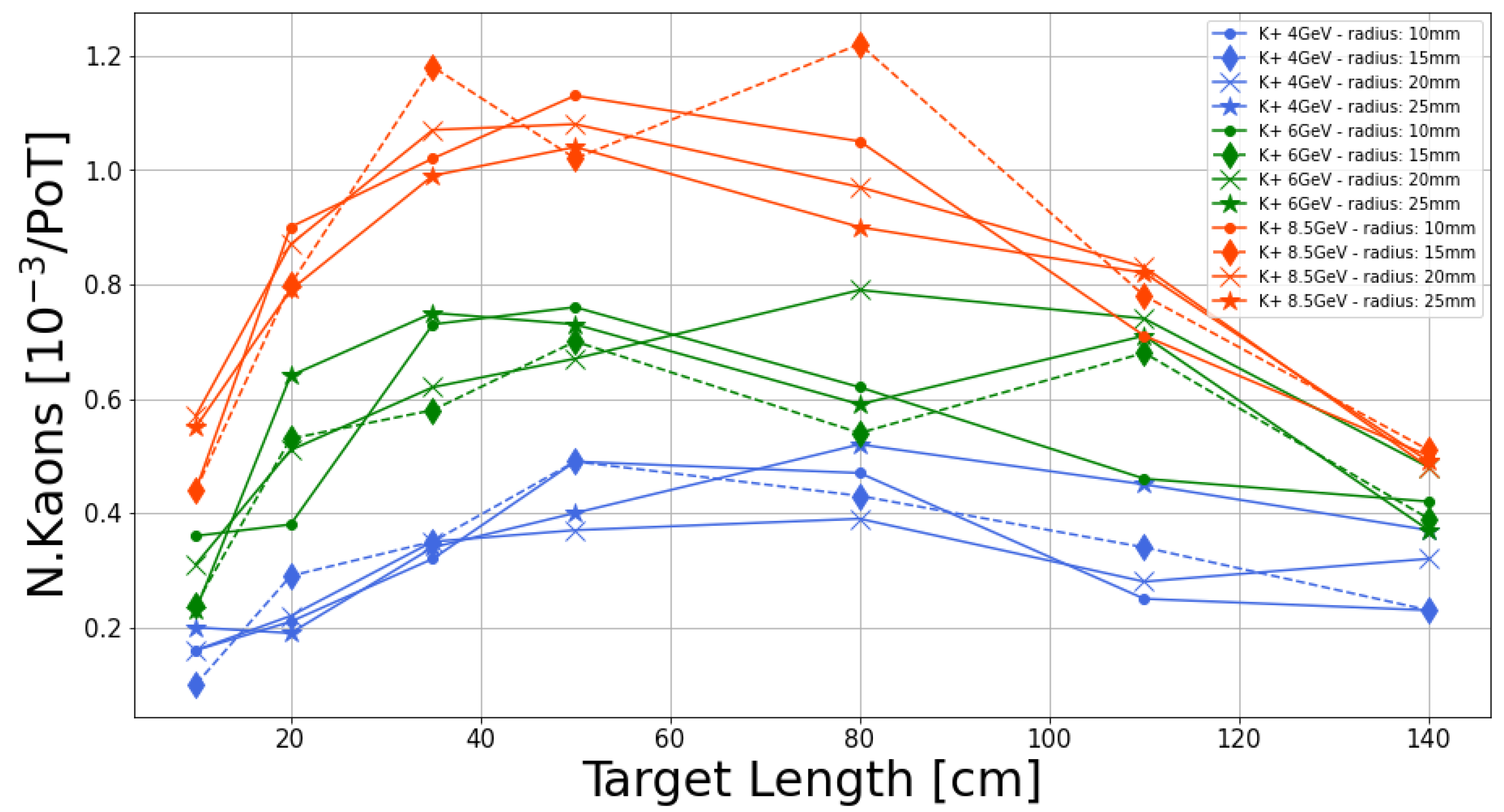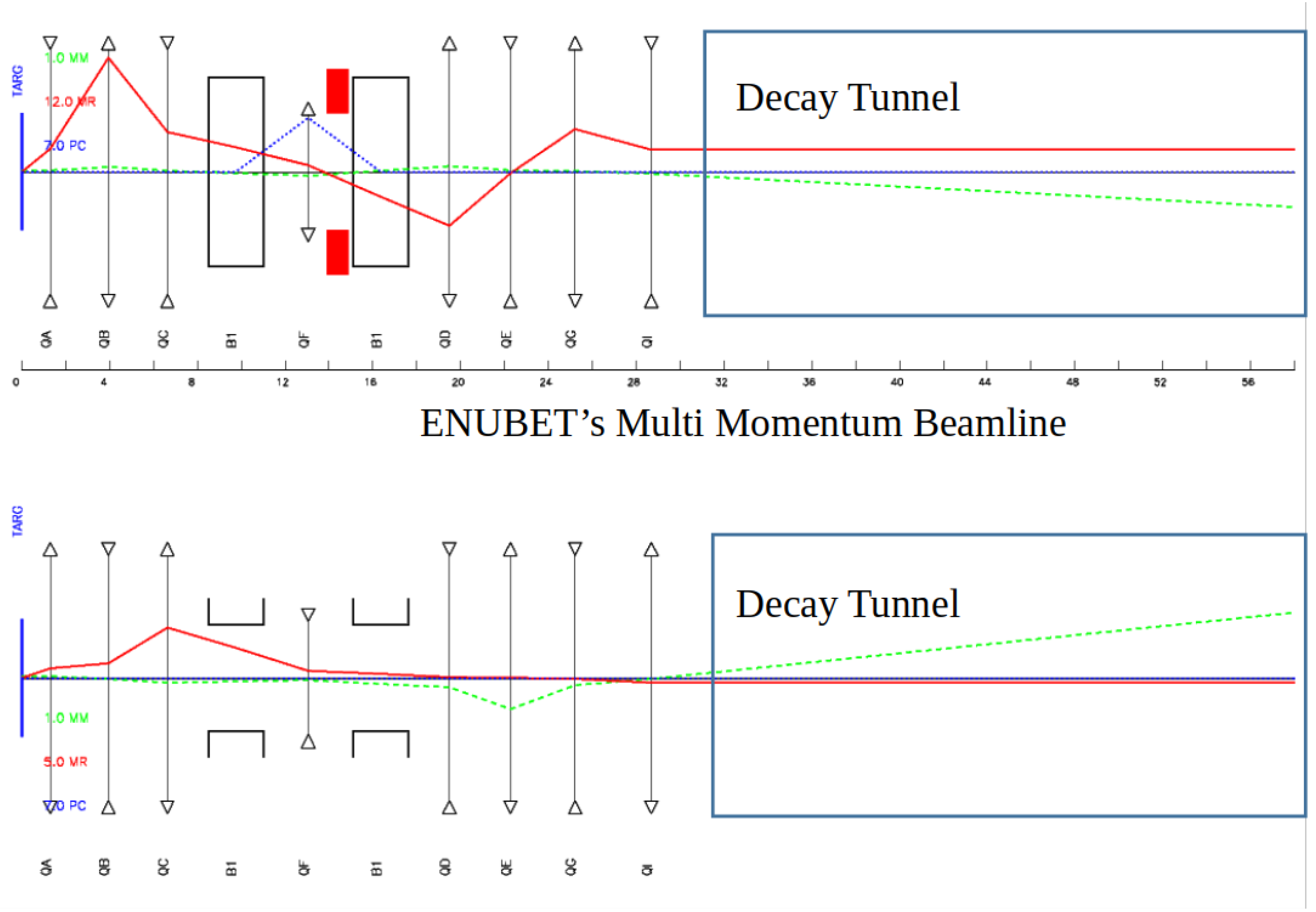The Design of the ENUBET Beamline †
Abstract
:1. The ENUBET Project
2. Proton Extraction
3. Target Studies
4. Baseline Studies
Optimization Algorithms
5. Multi-Momentum Line Studies
6. Conclusions
Author Contributions
Funding
Institutional Review Board Statement
Informed Consent Statement
Conflicts of Interest
References
- Berra, A.; Bonesini, M.; Brizzolari, C.; Calviani, M.; Catanesi, S.; Cindolo, F.; Collazuol, G.; Conti, E.; Dal Corso, F.; De Rosa, G.; et al. Enabling Precise Measurements of Flux in Accelerator Neutrino Beams: The ENUBET Project. (CERN,2016). Available online: https://cds.cern.ch/record/2221984 (accessed on 18 September 2023).
- Charitonidis, N.; Longhin, A.; Pari, M.; Parozzi, E.G.; Terranova, F. Design and diagnostics of high-precision accelerator neutrino beams. Appl. Sci. 2021, 11, 1644. [Google Scholar] [CrossRef]
- Acerbi, F.; Ballerini, G.; Bonesini, M.; Brizzolari, C.; Brunetti, G.; Calviani, M.; Carturan, S.; Catanesi, M.; Cecchini, S.; Cindolo, F.; et al. The ENUBET Project. (CERN, 2018). Available online: https://cds.cern.ch/record/2645532 (accessed on 18 September 2023).
- Pari, M.; Fraser, M.; Goddard, B.; Kain, V.; Stoel, L.; Velotti, F. Model and measurements of cern-sps slow extraction spill re-shaping—the burst mode slow extraction. In Proceedings of the 10th International Particle Accelerator Conference (IPAC’19), Melbourne, Australia, 19–24 May 2019; JACOW Publishing: Geneva, Switzerland, 2019; pp. 2406–2409. [Google Scholar]
- Ahdida, C.; Bozzato, D.; Calzolari, D.; Cerutti, F.; Charitonidis, N.; Cimmino, A.; Coronetti, A.; D’Alessandro, G.L.; Donadon Servelle, A.; Esposito, L.S.; et al. New Capabilities of the FLUKA Multi-Purpose Code. Front. Phys. 2022, 9, 788253. [Google Scholar] [CrossRef]
- Böhlen, T.; Cerutti, F.; Chin, M.; Fassò, A.; Ferrari, A.; Ortega, P.G.; Mairani, A.; Sala, P.R.; Smirnov, G.; Vlachoudis, V. The FLUKA code: Developments and challenges for high energy and medical applications. Nucl. Data Sheets 2014, 120, 211–214. [Google Scholar] [CrossRef]
- Roberts, T.J.; Beard, K.; Ahmed, S.; Huang, D.; Kaplan, D.M. G4Beamline particle tracking in matter dominated beam lines. In Proceedings of the EPAC’08, Italy, Genoa, 23–27 June 2008; pp. 2776–2779. [Google Scholar]
- Beringer, J. Particle data group. Phys. Rev. D 2012, 86, 10001. [Google Scholar] [CrossRef]
- Hurh, P.; Caretta, O.; Davenne, T.; Densham, C.; Loveridge, P.; Simos, N. High-power targets: Experience and R&D for 2 MW. arXiv 2012, arXiv:1208.2681. [Google Scholar]
- Simos, N.; Quaranta, E.; Charitonidis, N.; Sprouster, D.; Zhong, Z.; Ghose, S.; Kotsina, Z.; Assmann, R.; Redaelli, S.; Bertarelli, A.; et al. Radiation damage of a two-dimensional carbon fiber composite (CFC). Carbon Trends 2021, 3, 100028. [Google Scholar] [CrossRef]
- Brown, K.L.; Carey, D.C.; Iselin, F.C.; Rothacker, F. TRANSPORT: A Computer Program for Designing Charged-Particle Beam-Transport Systems; CERN Yellow Reports: Monographs; CERN: Geneva, Switzerland, 1980. [Google Scholar] [CrossRef]
- Collaboration, G.; Agostinelli, S. GEANT4–a simulation toolkit. Nucl. Instrum. Meth. A 2003, 506, 250–303. [Google Scholar]
- Charitonidis, N.; Efthymiopoulos, I. Low energy tertiary beam line design for the CERN neutrino platform project. Phys. Rev. Accel. Beams 2017, 20, 111001. [Google Scholar] [CrossRef]
- Parozzi, E.; Brunetti, G.; Charitonidis, N.; Longhin, A.; Pari, M.; Pupilli, F.; Terranova, F. The ENUBET Multi Momentum Secondary Beamline Design. Jacow Ipac 2021, 2021, 3053–3056. [Google Scholar]
- Lopez, R.; Anglada, J.R. The New Magnet System for the East Area at CERN. IEEE Trans. Appl. Supercond. 2020, 30, 4001605. [Google Scholar] [CrossRef]
- Rinella, G.A.; Feito, D.A.; Arcidiacono, R.; Biino, C.; Bonacini, S.; Ceccucci, A.; Chiozzi, S.; Gil, E.C.; Ramusino, A.C.; Danielsson, H.; et al. The NA62 GigaTracKer: A low mass high intensity beam 4D tracker with 65 ps time resolution on tracks. J. Instrum. 2019, 14, 07010. [Google Scholar] [CrossRef]
- NA62 Collaboration 2020 NA62 Status Report to the CERN SPSC. (CERN,2020). Available online: https://cds.cern.ch/record/2713499 (accessed on 18 September 2023).





| Particles (10/PoT) | 8.5 GeV/c | 6 GeV/c | 4 GeV/c |
|---|---|---|---|
| Baseline Beamline | |||
| K | 0.34 | / | / |
| 4.13 | / | / | |
| Optimized Baseline Beamline | |||
| K | 0.43 | / | / |
| 5.1 | / | / | |
| Multi-Momentum Beamline | |||
| K | 0.68 | 0.28 | 0.08 |
| 7.9 | 4.1 | 1.7 |
Disclaimer/Publisher’s Note: The statements, opinions and data contained in all publications are solely those of the individual author(s) and contributor(s) and not of MDPI and/or the editor(s). MDPI and/or the editor(s) disclaim responsibility for any injury to people or property resulting from any ideas, methods, instructions or products referred to in the content. |
© 2023 by the authors. Licensee MDPI, Basel, Switzerland. This article is an open access article distributed under the terms and conditions of the Creative Commons Attribution (CC BY) license (https://creativecommons.org/licenses/by/4.0/).
Share and Cite
Parozzi, E.G.; Acerbi, F.; Angelis, I.; Bomben, L.; Bonesini, M.; Bramati, F.; Branca, A.; Brizzolari, C.; Brunetti, G.; Calviani, M.; et al. The Design of the ENUBET Beamline. Phys. Sci. Forum 2023, 8, 65. https://doi.org/10.3390/psf2023008065
Parozzi EG, Acerbi F, Angelis I, Bomben L, Bonesini M, Bramati F, Branca A, Brizzolari C, Brunetti G, Calviani M, et al. The Design of the ENUBET Beamline. Physical Sciences Forum. 2023; 8(1):65. https://doi.org/10.3390/psf2023008065
Chicago/Turabian StyleParozzi, E. G., F. Acerbi, I. Angelis, L. Bomben, M. Bonesini, F. Bramati, A. Branca, C. Brizzolari, G. Brunetti, M. Calviani, and et al. 2023. "The Design of the ENUBET Beamline" Physical Sciences Forum 8, no. 1: 65. https://doi.org/10.3390/psf2023008065
APA StyleParozzi, E. G., Acerbi, F., Angelis, I., Bomben, L., Bonesini, M., Bramati, F., Branca, A., Brizzolari, C., Brunetti, G., Calviani, M., Carturan, S., Catanesi, M. G., Cecchini, S., Charitonidis, N., Cindolo, F., Cogo, G., Collazuol, G., Dal Corso, F., Delogu, C., ... Votano, L., on behalf of the ENUBET Collaboration. (2023). The Design of the ENUBET Beamline. Physical Sciences Forum, 8(1), 65. https://doi.org/10.3390/psf2023008065










